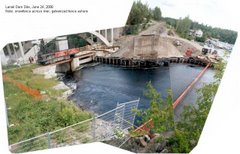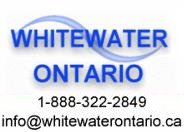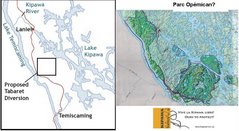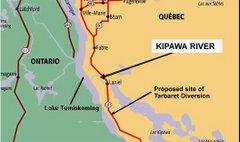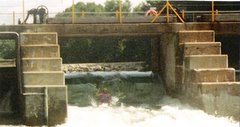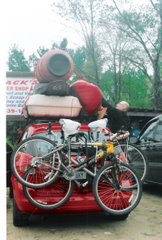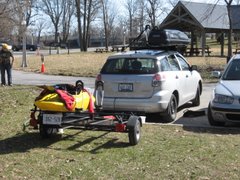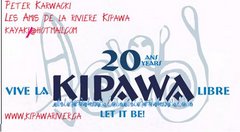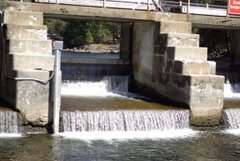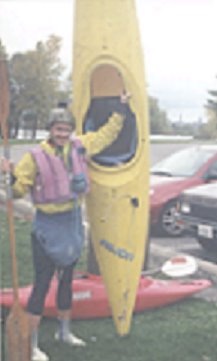
In January of this year, Lawrence Cannon, the federal Minister of Transport asked the Standing Committee for Transport, Infrastructure and Communities (TRAN) to begin hearings on proposed changes to the Navigable Waters Protection Act (NWPA).
Pursuant to its mandate under Standing Order 108(2), the Committee has studied the proposed amendments and has published his report named "CONSIDERATION OF PROPOSED AMENDMENTS TO THE NAVIGABLE WATERS PROTECTION ACT" on June 12th, 2008.
http://cmte.parl.gc.ca/cmte/CommitteePublication.aspx?COM=13202&SourceId=243590
Hereafter you will find excerpts of this report and related excerpts of the hearings.
A. Definition of Navigable Waters
The government amend the definition of navigable waters to exclude minor waters and that the new definition should clearly state what constitutes a “navigable water.”
Mr. David Osbaldeston (Manager, Navigable Waters Protection Program, Department of Transport) (12/02/2008-1205):
http://cmte.parl.gc.ca/Content/HOC/committee/392/tran/evidence/ev3274882/tranev13-e.htm#T1205
"Right now, in accordance with what the courts have determined, if you can float a canoe or a kayak, regardless of how long or how far, it's navigable."
Mr. Don Johnson (President, Alberta Association of Municipal Districts and Counties, Federation of Canadian Municipalities) (29/04/2008-1120) :
http://cmte.parl.gc.ca/Content/HOC/committee/392/tran/evidence/ev3453770/tranev23-e.htm#T1120
"For further clarity, a navigable water:
(a) must be, for at least three consecutive months of the year, capable of supporting typical transportation, commercial, or recreational type floating vessels that draw a draft of at least one metre;
(b) must be at least two kilometres in length and contain no fixed and permanent restrictions for floating vessels referred to earlier...;
(c) may be a man-made or naturally occurring water body...
In addition, a water body meeting all these criteria may be nominated for designation as a navigable water by one level of government only, either municipal, provincial, or federal."
Question 1:
If navigation is denied on bodies of water that don't comply to Mr. Don Johnson's proposed criterions, do you think this denial would have an impact on your or on your organization activities ?
B. Definition of Work
The government amend the definition of “work” under the NWPA to exclude “minor works.”
Mr. Brian Masse (Windsor West, NDP) (28/02/2008-1205):
http://cmte.parl.gc.ca/Content/HOC/committee/392/tran/evidence/ev3312419/tranev14-e.htm#T1205
"I looked at the minor works, and you had dredging, submarine cables, docks, pipeline crossings. "
TC: http://www.tac-atc.ca/private/environment/pdf/att3-0406.pdf
"List of minor works:
dredging, submarine cables, docks, pipeline crossings, riprap, intakes, winter crossings. "
Question 2:
Do you think dredging, submarine cables, docks, pipeline crossings, riprap, intakes, winter crossings don't have a meaningfull impact on navigation ?
C. Remove Reference to Four “Named” Works
The government consider deleting specific reference to each of the four “named“ works under Section 5(2) of the Navigable Waters Protection Act without compromising the review of works which impede or obstruct navigation.
Ms. Shirley Anne Scharf (Director General, Issues Management Directorate, Program Operations Branch, Infrastructure Canada) (11/03/2008-1115):
http://cmte.parl.gc.ca/Content/HOC/committee/392/tran/evidence/ev3350146/tranev16-e.htm#T1115
"In addition, the proposal to remove the named works from the NWPA would also allow for quicker approval of those named works that are not a significant interference to navigation, such as small bridges, causeways, and micro-hydroelectric projects. "
Mr. Marc Grégoire (Assistant Deputy Minister, Safety and Security, Department of Transport) (28/02/2008-1140):
http://cmte.parl.gc.ca/Content/HOC/committee/392/tran/evidence/ev3312419/tranev14-e.htm#T1140
"Subsection 5(2) of the act contains four named works. They are “bridge, boom, dam...[and] causeway”. These four works were originally named, back in 1882, specifically in the act, as they completely blocked the waterway and thus were traditionally considered significant interferences to navigation. Today in 2008, this is not true any more."
Question 3:
Do you aggree with Mr.Gregoire on the fact the navigation has evolve in a way that it can no more be impeded or obstructed by bridges, booms, dams and causeways ?
D. Inter-Departmental Assessment “Triggers”
The government, in amending the NWPA, ensure that the “trigger” mechanisms contained in other pieces of relevant legislation for environmental assessments and fisheries habitat assessments are not done away with or impeded.
Mr. John Smith (Director, Legislative and Regulatory Affairs, Policy Development, Canadian Environmental Assessment Agency) (11/03/2008-1120):
http://cmte.parl.gc.ca/Content/HOC/committee/392/tran/evidence/ev3350146/tranev16-e.htm#T1120
"In factoring environmental considerations into the planning and decision-making process at an early stage, EA is an important tool for promoting sustainable development...
The proposed changes to the NWPA would mean that minor works and projects in minor waters would not require NWPA approval; consequently, they would not trigger an environmental assessment."
Mr. David Osbaldeston (Manager, Navigable Waters Protection Program, Department of Transport) (12/02/2008-1255)
http://cmte.parl.gc.ca/Content/HOC/committee/392/tran/evidence/ev3274882/tranev13-e.htm#T1255
"Suppose MacMillan Bloedel wants to go into a piece of New Brunswick...
In the past they used to come in and say they were going to clear-cut up here, and were there any navigational concerns?...
We'd take a quick look at it and we'd say no--just go. They'd go in and they'd do their thing with their temporary bridges....
Then came the introduction of ISO standards...
All of a sudden we start having these guys show up with 3,000 applications in hand, saying now they need us to produce 3,000 pieces of paper for them on waterways that for the most part would be covered under these minor waterways that nobody's ever going to put a canoe or a kayak on...
In a changed act, one way would be that if you had 3,000 bridges that really mattered, all on a similar type of waterway on a given project, you could come to us and maybe we'd review it and issue you one document for the 3,000 bridges"
Question 4:
Knowing that selective cuts allow to reach a productivity which is 3 times higher than clear cuts, do you think that the proposed changes would transform the NWPA in a important tool for promoting sustainable development ?
Mr. David Osbaldeston (Manager, Navigable Waters Protection Program, Department of Transport) (28/02/2008-1215):
http://cmte.parl.gc.ca/Content/HOC/committee/392/tran/evidence/ev3312419/tranev14-e.htm#T1215
"As you can see, there's very little we deny or refuse. I think that's the main thing: if somebody has a need to put something in the water, over the water, under the water, or through the water, and has a valid need to do it, we'll try our utmost to get it done in a safe manner."
Question 5:
Do you think this is the best way to protect your navigation rights ?
Ms. Shirley Anne Scharf (Director General, Issues Management Directorate, Program Operations Branch, Infrastructure Canada) (03/06/2008-1115):
http://cmte.parl.gc.ca/Content/HOC/committee/392/tran/evidence/ev3543792/tranev30-e.htm#T1115
"Certainly I understand the concerns of the waterkeepers and their concerns about the environment. So we appreciate that fact. And we have not been engaged in consultations with them....
1220
With respect to your question about canoeists and whitewater enthusiasts, because Transport Canada was administering the act, they have led any consultations that have occurred."
Question 6:
Was your organization consulted on the proposed changes of the NWPA ?
Question 7:
Was your organization informed of the hearings on the proposed changes of the NWPA ?
Mr. Marc Grégoire (Assistant Deputy Minister, Safety and Security, Department of Transport) (12/02/2008-1120):
http://cmte.parl.gc.ca/Content/HOC/committee/392/tran/evidence/ev3274882/tranev13-e.htm#T1120
"This committee is the ideal forum in which to seek the viewpoints of stakeholders who have a vested interest in a new Navigation Protection Act. The committee would provide Transport Canada with an unbiased consideration of the issues and could look at solutions from a fresh perspective. This would be vitally important to the initiative's outcome...
The Navigation Protection Act impacts a wide range of Canadians and areas."
Question 8:
Based on the List of Witnesses (Appendix A) and List of briefs (Appendix B) of the report, do you think the committee could address all the interests of Canadians about the NWPA ?
http://cmte.parl.gc.ca/cmte/CommitteePublication.aspx?COM=13202&SourceId=243590
Appendix A
List of Witnesses
Department of Transport
Marc Grégoire, Assistant Deputy Minister, — Safety and Security
David Osbaldeston, Manager, — Navigable Waters Protection Program
William J. Nash, Director General, — Marine Safety
Canadian Environmental Assessment Agency
Steve Burgess, Acting Vice-President, — Program Delivery Sector
John Smith, Director, — Legislative Regulatory Affairs, Policy Development
Yves Leboeuf, Vice-President, — Policy Development
Department of Fisheries and Oceans
Gilles Belzile, Director General, — Legislative and Intergovernmental Affairs, Policy Sector
Ginny Flood, National Director, — Environmental Assessments and Major Projects, Oceans and Habitat Sector
Infrastructure Canada
Keith Grady, Senior Advisor, — Environment Review and Approvals, Issues Management Directorate, Program Operations Branch
Shirley Anne Scharf, Director General, — Issues Management Directorate, Program Operations Branch
Federation of Canadian Municipalities
Susan Irwin, Senior Policy and Research Analyst
Don Johnson, President, — Alberta Association of Municipal Districts and Counties
David Marit, President, — Saskatchewan Association of Rural Municipalities
Government of Alberta
Ron Middleton, Director, — Environmental Management Services, Ministry of Transportation
Appendix B
List of Briefs
Beaver County
Brazeau County
Canadian Construction Association
Canadian Environmental Assessment Agency
Canoe Kayak Nova Scotia
Council of Marine Carriers
County of Minburn No. 27
County of Thorhild No. 7
County of Wetakiwin No. 10
Department of Transport
Federation of Canadian Municipalities
Government of Alberta, Alberta Transportation
Government of British Columbia, Ministry of Transportation
Government of Manitoba, Infrastructure and Transportation
Government of Newfoundland and Labrador, Department of Transport and Works
Government of the Northwest Territories, Department of Transport
Government of Nova Scotia, Transportation and Infrastructure
Government of Ontario, Ministry of Transportation
Government of Saskatchewan, Ministry of Highways and Infrastructure
Government of Yukon, Department of Highways and Public Works
Heather Matthews
Lake Ontario Waterkeeper
Les Amis de la Rivière Kipawa
Mackenzie County
Municipal District of Wainwright No. 61
Ponoka County
Township of Enniskillen
Western Canada Roadbuilders & Heavy Construction Association



